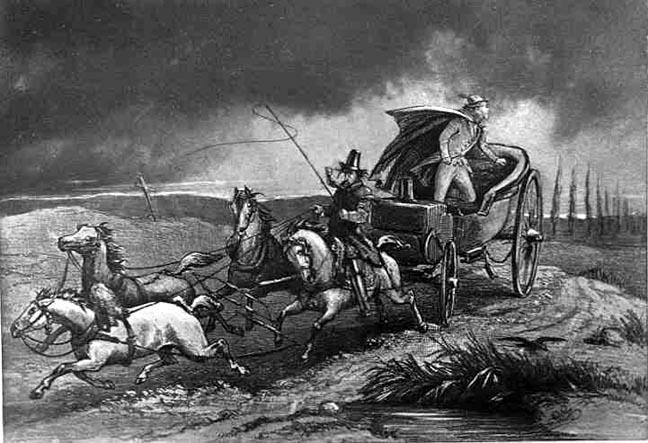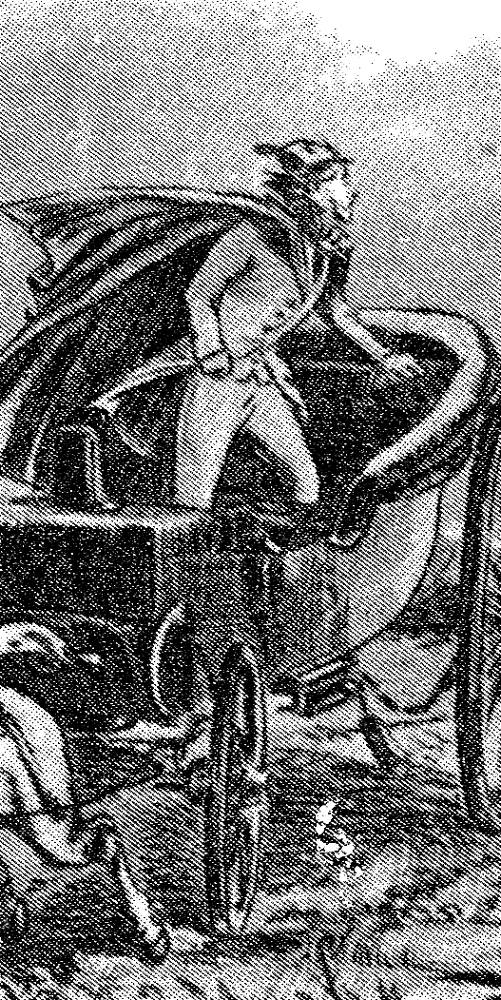
"Or rising to see where the moon shone faintly on a patch of the same endless road miles away, or looking back to see who followed" was originally entitled On the dark Road. This was the thirty-seventh illustration and Phiz's only dark plate for Dickens's Dombey and Son (March 1848, Part 18), Chapter 55, facing 592 (1880 edition: Ch. XXV, facing 399 in vol. 2) by Phiz (Hablot K. Browne). Photogravure [1912?], facing p. 877 but illustrates p. 870 in Dickens's Dombey and Son in the Co-operative Publication Society Edition. 13.5 cm high by 9.3 cm wide (4 ½ x 7 ½ inches), framed. Terry-Lynn Johnson Collection. [Click on the image to enlarge it.]
Passage Illustrated: Complementing Phiz's Atmospheric Masterpiece
"Monsieur has walked a long way in the dark midnight."
"No matter. Everyone to his task. Were there any other horses ordered at the Post-house?"
"A thousand devils! — and pardons! other horses? at this hour? No."
"Listen, my friend. I am much hurried. Let us see how fast we can travel! The faster, the more money there will be to drink. Off we go then! Quick!"
"Halloa! whoop! Halloa! Hi!" Away, at a gallop, over the black landscape, scattering the dust and dirt like spray!
The clatter and commotion echoed to the hurry and discordance of the fugitive's ideas. Nothing clear without, and nothing clear within. Objects flitting past, merging into one another, dimly descried, confusedly lost sight of, gone! Beyond the changing scraps of fence and cottage immediately upon the road, a lowering waste. Beyond the shifting images that rose up in his mind and vanished as they showed themselves, a black expanse of dread and rage and baffled villainy. Occasionally, a sigh of mountain air came from the distant Jura, fading along the plain. Sometimes that rush which was so furious and horrible, again came sweeping through his fancy, passed away, and left a chill upon his blood.
The lamps, gleaming on the medley of horses' heads, jumbled with the shadowy driver, and the fluttering of his cloak, made a thousand indistinct shapes, answering to his thoughts. Shadows of familiar people, stooping at their desks and books, in their remembered attitudes; strange apparitions of the man whom he was flying from, or of Edith; repetitions in the ringing bells and rolling wheels, of words that had been spoken; confusions of time and place, making last night a month ago, a month ago last night — home now distant beyond hope, now instantly accessible; commotion, discord, hurry, darkness, and confusion in his mind, and all around him. — Hallo! Hi! away at a gallop over the black landscape; dust and dirt flying like spray, the smoking horses snorting and plunging as if each of them were ridden by a demon, away in a frantic triumph on the dark road — whither? [Chapter LV, "Rob the Grinder loses his Place," 590-91; vol. II, 398-99]
Commentary: Phiz's Adaptation of the "Dark Plate" Technique
The illustration is unusual in that it is Phiz's fourth attempt at a vertical orientation, which he realised would enable him to select for illustration group scenes that were cramped by the usual horizontal orientation in which he had worked in The Pickwick Papers ten years earlier.

Detail of Carker, standing in the speeding carriage:
The illustration, On the Dark Road, is a plate on which a tint had first been placed by means of a ruling machine; and by a process of "stopping out" and "burnishing out" an effect equivalent to mezzotint was obtained. Notwithstanding the number of impressions taken from it, the plate is still in fair condition [as of 1884], and having been very carefully printed by Mr. Yates for this work, little or none of the beauty is gone. The original drawing, it should be mentioned, is very rough and crude, having only a mere indication of the design; the horses, however, are well drawn and clearer than the rest of the drawing. The subject is Carker in his flight from Dijon, after the meeting with Edith, when he thinks every sound tells of an avenger following close on his heels. "Shame, disappointment, and discomfiture gnawed at his heart; a constant apprehension of being overtaken oppressed him heavily." — David Croal Thomson, p. 124.
According to Valerie Lester Browne, this was Phiz's first attempt at a classic 'dark plate', in this case to show the futility of the villainous Carker's trying to cheat death as he makes his way through France to Paris and thence to England. If he cannot escape Dombey on the Continent (where he fears Dombey can easily hire assassins), he rationalizes that it would be better to confront Dombey in a country less lawless. The March 1848 illustration, moreover, engages the viewer with the sharpness and vivacity of the figures and the prancing horses — horses having been from his earliest compositions one of Phiz's strengths. Better reproductions of this powerful illustration convey the aerial perspective through making clear the line of Lombardy poplars running off to the horizon, upper right.
For the illustration, On the Dark Road, Phiz turned the plate horizontally and used a ruling machine, which pushed a bank of needles across the wax ground on the plate, creating a background of narrow stripes, akin to mezzotinting. (The technique is sometimes referred to as 'machine tinting'.) He then drew into dark areas to make them blacker and produced a variety of greys by stopping-out other areas. To retain the dazzling whites, he burnished away the ruled lines and stopped out those areas completely on the first and all subsequent visits to the acid.
Phiz's use of a ruling machine was a divergence from the more popular aquatint method used by other etchers. He may have disliked aquatint's time-consuming use of resin, a messy substance which, if inhaled, could injure the lungs. With his ruling machine he created tones with less nuisance. (After his experiments on Lever's Roland Cashel (1850), he no longer used the ruling machine for light topics; the brights were never bright enough.)
On the Dark Road is one of the most completely successful of all Phiz's images. A long, slow diagonal slices down from receding poplar trees in the upper right to the coach and standing figure of windswept Carker, and moves on down through the coachman (who provides an opposing diagonal with his whip) to the four horses racing towards the bottom left of the picture. Phiz took enormous technical care with the plate, and its atmosphere of menace is enhanced by the addition of details: a black bird, a dark pool, a lowering sky, a leaning finger-post, and the rolling eyes and hot breath of the horses. [Lester, 135-136]
Related Material: Other Illustrated Editions of Dombey and Son (1848-1910)
- Dombey and Son (homepage)
- Dark Plate Etchings by "Phiz" for Bleak House
- Phiz: "A Good Hand at a Horse" — A Gallery. . .
- F. O. C. Darley's Frontispiece in the New York edition (Vol. 1, 1862)
- F. O. C. Darley's Frontispiece in the New York edition (Vol. 2, 1862)
- F. O. C. Darley's Frontispiece in the New York edition (Vol. 3, 1862)
- Sol Eytinge, Junior's 16 Diamond Edition Illustrations (1867)
- Fred Barnard's 61 illustrations for the Household Edition (1877)
- Groome's illustrations of the Collins Pocket Edition of Dombey and Son (1900, rpt. 1934)
- Kyd's five Player's Cigarette Cards, 1910
- Harry Furniss's illustrations for the Charles Dickens Library Edition (1910)
Image scan, caption, and commentary by Philip V. Allingham. [You may use this image without prior permission for any scholarly or educational purpose as long as you (1) credit the person who scanned the image and (2) link your document to this URL in a web document or cite the Victorian Web in a print one.]
Bibliography
Dickens, Charles. Dombey and Son. With illustrations by H. K. Browne. The Illustrated Library Edition. 2 vols. London: Chapman and Hall, c. 1880. Vol. II.
Dickens, Charles. Works. Photogravure-Illustrated Edition. Illustrated by various hands. New York and London: Co-operative Publication Society, [1912?].
Lester, Valerie Browne. Ch. 12, "Work, Work, Work." Phiz: The Man Who Drew Dickens. London: Chatto and Windus, 2004, pp. 128-160.
Steig, Michael. Chapter 4. "Dombey and Son: Iconography of Social and Sexual Satire." Dickens and Phiz. Bloomington & London: Indiana U. P., 1978. 86-112.
Thomson, David Croal. Life and Labours of Hablot Knight Browne — "Phiz.". London: Chapman and Hall, 1884.
Vann, J. Don. Chapter 4. "Dombey and Son, twenty parts in nineteen monthly installments, October 1846-April 1848." Victorian Novels in Serial. New York: Modern Language Association, 1985. 67-68.
Created 12 August 2012
Last modified 3 February 2025